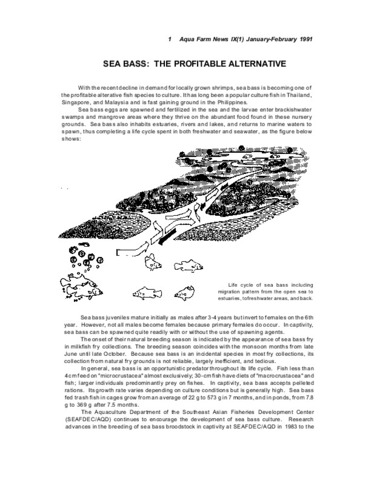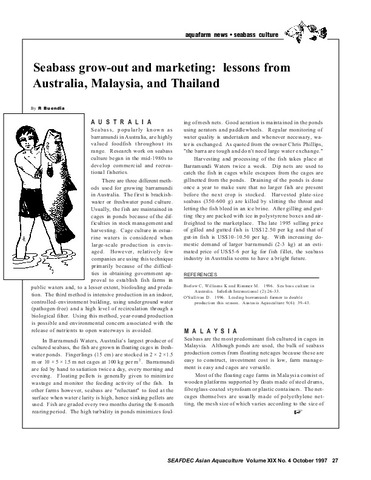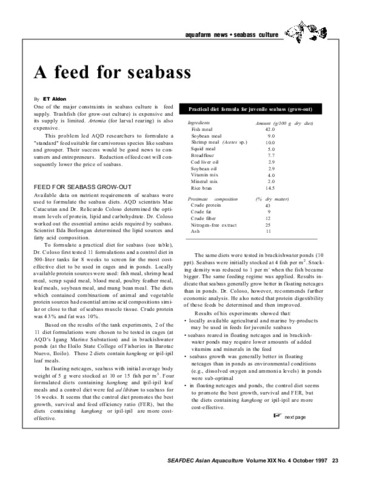Spontaneous maturation and spawning of sea bass Lates calcarifer in floating net cages
- Global styles
- MLA
- Vancouver
- Elsevier - Harvard
- APA
- Help

View/
Date
1991Page views
2,290ASFA keyword
AGROVOC keyword
Taxonomic term
Metadata
Show full item record
Share
Abstract
Male and female sea bass (Lates calcarifer Bloch) from 1982 wild-caught juveniles reared in floating net cages matured at about 2.0–2.5 years (mean body weight =1.1 kg; mean total length = 42.0 cm) and 3–4 years (2,7 kg; 54.5 cm), respectively. To monitor the occurrence of natural spawning, thirteen females were paired with twenty-eight males in a separate net cage in 1986. A “hapa” net with the same dimension as the net cage was installed to retain the spawned eggs. Spontaneous spawning occurred from June to October. The monthly total number of eggs collected varied from 393,000 to 60 million. Spawning appeared to be related to the lunar phase. Of the 26 recorded spawnings, seventeen took place within four days before or after the first quarter moon, while nine occurred within five days before or three days after the last quarter moon. All spawnings were observed between 1900–2300 hrs. The results demonstrate the feasibility of breeding sea bass in floating net cages, which is relatively cheaper and simpler than other existing methods.
Suggested Citation
Toledo, J. D., Marte, C. L., & Castillo, A. R. (1991). Spontaneous maturation and spawning of sea bass Lates calcarifer in floating net cages. Journal of Applied Ichthyology , 7(4), 217-222. https://doi.org/10.1111/j.1439-0426.1991.tb00599.x
Type
ArticleISSN
1439-0426Collections
- Journal Articles [1258]
Related items
Showing items related by title, author, creator and subject.
-
Sea bass: The profitable alternative
Southeast Asian Fisheries Development Center, Aquaculture Department (Aquaculture Department, Southeast Asian Fisheries Development Center, 1991) -
Seabass grow-out and marketing: lessons from Australia, Malaysia, and Thailand
Buendia, Romeo (Aquaculture Department, Southeast Asian Fisheries Development Center, 1997) -
A feed for seabass
Aldon, E. T. (Aquaculture Department, Southeast Asian Fisheries Development Center, 1997)One of the major constraints in seabass (Lates calcarifer) culture is feed supply. Details are given of work conducted at AQD regarding the formulation of a 'standard' feed suitable for carnivorous species like the seabass ...





